The AMD Ryzen 7 5700G, Ryzen 5 5600G, and Ryzen 3 5300G Review
by Dr. Ian Cutress on August 4, 2021 1:45 PM EST
Earlier this year, AMD launched its Zen 3 based desktop processor solutions with integrated graphics. Marketed as the Ryzen 5000G family, these processors are the latest offering to combine AMD’s high-performing Zen 3 cores with tried-and-tested Vega 8 graphics, all built on TSMC’s 7nm process. As desktop processors, AMD made them available to system builders for a few months, allowing the company to keep track of stock levels and have a consistent demand during a high-demand phase for silicon. But on August 5th, they will be made available to buy at retail, and we’ve got the most important models to test.
The AMD Ryzen 5000G APUs: Cezanne Silicon
AMD actually came to market with its Zen 3-based integrated graphics silicon back in December 2020. The Cezanne silicon, with eight Zen 3 cores and up to Vega 8 graphics, was first earmarked for laptop use. We saw it come to market in that fashion for the 15 W and 45 W segments, and tested it in the ASUS ROG Flow X13 laptop in a 35 W variation, paired with a discrete graphics card.
AMD Ryzen 9 5980HS Cezanne Review: Ryzen 5000 Mobile Tested
As a mobile chip in both low power and high power segments, it had to do duty as both a processor and graphics at 15 W, but mainly as a processor at 45 W powering a discrete graphics card. For the desktop processors, AMD cranks up the power even more to 65 W, where it is expected to perform either as a good CPU powering a GPU, or as an integrated graphics solution and do everything.
The Ryzen 5000G processor series is an upgrade over last year’s Ryzen 4000G processor series. AMD co-designed both of these processor families to re-use key parts of the chip design, enabling a fast time-to-market and quicker upgrade cycle for AMD’s partners (OEMs), like Dell, HP, Lenovo, and others. The biggest re-use between the two families is the graphics, which has Vega 8 graphics on both, and although there’s a hefty frequency bump for 5000G in mobile, the desktop parts actually see a decline. We expect AMD to have its latest RDNA 2 graphics in its G processors next time around, but for now it stays the same because that helps expedite the design for these processors.
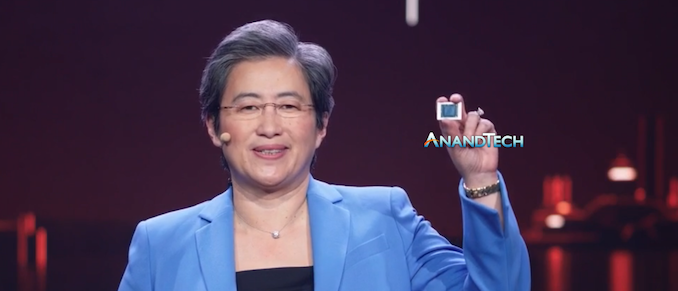 AMD CEO, Dr. Lisa Su, with Cezanne silicon
AMD CEO, Dr. Lisa Su, with Cezanne silicon
The major difference between the 4000G and 5000G processors is that the new hardware uses eight of AMD’s latest Zen 3 CPU cores, which is an upgrade over the eight Zen 2 cores from last year. The highlight is the +19% raw performance uplift when comparing the two at the same frequency. The second major difference is that the 4000G processors never technically came to retail (but we reviewed them anyway), while AMD is making the Ryzen 7 5700G and Ryzen 5 5600G as individual products that customers can buy.
Under the hood, there are a few more key changes that enthusiasts will be interested in. The 8-core Zen 3 design doubles the L3 cache per core, but also combines it into a single 16 MB L3 cache structure. This enables any of the eight cores to access the full cache, reducing latency to main memory (from 4 MB to 16 MB). The previous design had two clusters of four Zen 2 cores, so while it still had 8 cores, each cluster only had access to 4 MB of L3 cache. This is of sizable importance when it comes to workloads that sit in the 4 MB to 16 MB memory space, such as integrated graphics gaming and discrete graphics.
The new processor is 180 mm2 in size, compared to 156 mm2 of the last generation, but still fits into the same socket. It contains 10.7 billion transistors, which is up from 9.8 billion. This means an effective decrease in transistor density, although we know that Zen 3 cores are slightly larger than Zen 2 cores, and some additional security measures have been added.
There are six desktop processors in this family, and two of them are coming to store shelves.
| AMD Ryzen 5000G Series APUs | |||||||
| AnandTech | Core / Thread |
Base Freq |
Turbo Freq |
GPU CUs |
GPU Freq |
PCIe * |
TDP |
| Ryzen 5000G | |||||||
| Ryzen 7 5700G | 8 / 16 | 3800 | 4600 | 8 | 2000 | 16+4+4 | 65 W |
| Ryzen 7 5700GE | 8 / 16 | 3200 | 4600 | 8 | 2000 | 16+4+4 | 35 W |
| Ryzen 5 5600G | 6 / 12 | 3900 | 4400 | 7 | 1900 | 16+4+4 | 65 W |
| Ryzen 5 5600GE | 6 / 12 | 3400 | 4400 | 7 | 1900 | 16+4+4 | 35 W |
| Ryzen 3 5300G | 4 / 8 | 4000 | 4200 | 6 | 1700 | 16+4+4 | 65 W |
| Ryzen 3 5300GE | 4 / 8 | 3600 | 4200 | 6 | 1700 | 16+4+4 | 35 W |
| *PCIe lanes on the SoC are listed in 16xGFX + 4xChipset + 4 for NVMe | |||||||
The top part is a Ryzen 7 5700G, featuring eight cores and sixteen threads, with a base frequency of 3.8 GHz and a turbo frequency of 4.6 GHz. The Vega 8 graphics runs at 2000 MHz, and we get sixteen lanes of PCIe 3.0 for graphics, plus another four for storage and four for the chipset.. TDP of the chip is rated at 65 W, although in most motherboards the Package Power Tracking will bump power up to 88 W. The Ryzen 7 5700G will have an MSRP of $359.
The second part is a Ryzen 5 5600G, featuring six cores and twelve threads, with a base frequency of 3.9 GHz and a turbo frequency of 4.6 GHz. It drops down in graphics to Vega 7, running at 1900 MHz, but has the same PCIe 3.0 and TDP settings as the Ryzen 7. AMD has indicated that the 5600G should retail for $259.
We’re also testing a third part in this review, the Ryzen 3 5300G, which sits near the bottom of the stack. With only four cores and eight threads, up to 4.2 GHz turbo and Vega 6 graphics running at 1700 MHz, this processor contains only half the L3 cache (8 MB total) of the other two. It sounds like it would make a nice $150 processor if it came to retail, and users can pick this processor up on eBay, but it currently it sits at $272 plus shipping, making it more expensive than the 5600G. Nonetheless, as we had tested Ryzen 7/5/3 from the 4000G series, we wanted to compare up against the 5000G to see if this is a line AMD might consider going beyond OEM deployment.
This is ultimately why a staggered launch from laptop to desktop over the course of eight months allows AMD to pitch where its desktop integrated graphics processors should sit in the marketplace. These Cezanne processors use Zen 3 CPU cores, for example, whereas the older ones had Zen 2, Zen+, and Zen before it. What makes these ones different this time around is that AMD is cutting the Ryzen 3 from retail, but the Ryzen 7 at the high-end is now available at retail. The only one that has been consistent is Ryzen 5, and we can compare the Ryzen 5 processors over the years:
| Ryzen 5 APUs (65W) | |||||||||
| AnandTech | Cores | Base Freq |
Turbo Freq |
L3 MB |
PCIe | GPU | DDR4 | Price | |
| Zen3 7nm |
Ryzen 5 5600G | 6 / 12 | 3900 | 4400 | 16 | 3.0 x24 | Vega8 | 3200 | $259 |
| Zen2 7nm |
Ryzen 5 4650G | 6 / 12 | 3700 | 4200 | 4+4 | 3.0 x24 | Vega8 | 3200 | OEM |
| Zen+ 12nm |
Ryzen 5 3400G | 4 / 8 | 3700 | 4200 | 4 | 3.0 x8 | Vega11 | 2933 | $149 |
| Zen 14nm |
Ryzen 5 2400G | 4 / 8 | 3600 | 3900 | 4 | 3.0 x8 | Vega11 | 2933 | $169 |
AMD has kept the Vega graphics through all four generations, but moved down from the silicon having Vega 11 on 12nm to Vega 8 on 7nm – AMD said that this was because of density increases and finding the right balance, but also the uplift in frequency and power efficiencies the new process node provided.
As it stands, these two new processors at retail fill out AMD's retail offerings, at least down to $259. One of the key benefits is that these two new processors are cheaper than the existing CPU-only offerings, but also both come with appropriate coolers when they are run at their default power modes. Otherwise, the most notable differences between AMD's Ryzen 5000 CPUs and 5000G APUs comes down to the APUs only have half as much L3 cache, and of course, the APUs also come with integrated graphics. Given that modern graphics cards don’t even need PCIe 4.0 levels of bandwidth, we have to see if the cache difference and any CPU frequency differences are worth the price difference.
| AMD Ryzen 5000 CPU vs APU Comparisons | |||||||||
| AnandTech | Core / Thread |
Base Freq |
Turbo Freq |
GPU CUs |
GPU Freq |
PCIe |
L3 MB |
TDP | SEP |
| Ryzen 7 | |||||||||
| Ryzen 7 5800X | 8 / 16 | 3800 | 4700 | - | - | 4.0 x24 | 32 | 105 W | $449 |
| Ryzen 7 5700G | 8 / 16 | 3800 | 4600 | 8 | 2000 | 3.0 x24 | 16 | 65 W | $359 |
| Ryzen 5 | |||||||||
| Ryzen 5 5600X | 6 / 12 | 3700 | 4600 | - | - | 4.0 x24 | 32 | 65 W | $299 |
| Ryzen 5 5600G | 6 / 12 | 3900 | 4400 | 7 | 1900 | 3.0 x24 | 16 | 65 W | $259 |
The key thing with the Ryzen 7 comparison is the TDP difference – why the frequency might only be 100 MHz change, at 105 W TDP (or 120W PPT), it will keep its turbo better.
Chipset Support
AMD has confirmed that X570, B550, and A520 motherboards will support the new 5000G processors. X470 and B450 motherboards might also be supported, but that depends on the motherboard manufacturer. AMD recommends a BIOS with AGESA version 1203b for full performance.
This Review
In this article, we will be testing the Ryzen 7 5700G, Ryzen 5 5600G, and Ryzen 3 5300G on our test suite, covering raw CPU performance, integrated graphics performance, but also performance when paired with a discrete GPU.
| AnandTech | Example Processors |
Motherboard | DRAM | PSU | SSD |
| AMD | |||||
| Zen3 APU | Ryzen 7 5700G | GIGABYTE X570 Aorus I Pro (F34) |
ADATA 32 GB DDR4-3200 |
Corsair AX860i |
Crucial MX500 2 TB |
| Ryzen 5 5600G | |||||
| Ryzen 3 5300G | |||||
| Zen2 APU | Ryzen 7 4750G | GIGABYTE X570 Aorus I Pro (F30a) |
ADATA 64 GB DDR4-3200 |
Corsair AX860i |
Crucial MX500 2 TB |
| Ryzen 5 4650G | |||||
| Ryzen 3 4350G | |||||
| Zen+ APU | Ryzen 5 3400G | GIGABYTE X570 Aorus I Pro (F30a) |
ADATA 64 GB DDR4-2933 |
Corsair AX860i |
Crucial MX500 2 TB |
| Zen APU | Ryzen 5 2400G | GIGABYTE X570 Aorus I Pro (F30a) |
ADATA 64 GB DDR4-2933 |
Corsair AX860i |
Crucial MX500 2 TB |
| Intel | |||||
| Rocket Lake | Core i7-11700K | ASUS Maximus XIII Hero |
BIOS 0610 |
Corsair AX1600i |
Crucial MX500 2TB |
| Broadwell | Core i7-5775C | GIGABYTE Z97X-UD5H (F10) |
Geil Veloce 16 GB DDR3-1600 |
Antec HCP 1250W |
Crucial MX500 2 TB |
| Core i5-5675C | |||||
| Tiger Lake | Core i7-1185G7 | Intel Reference |
32 GB LPDDR4X |
Integrated | Samsung PCIe 3.0 |
Many thanks to...
We must thank the following companies for kindly providing hardware for our multiple testbeds. Some of this hardware is not in this testbed specifically, but is used in other testing.
| Hardware Providers for CPU and Motherboard Reviews | |||
| Sapphire RX 460 Nitro |
NVIDIA RTX 2080 Ti |
Crucial SSDs | Corsair PSUs |
 |
 |
 |
|
| G.Skill DDR4 | ADATA DDR4 | Silverstone Coolers |
Noctua Coolers |
 |
 |
 |
|
A big thanks to ADATA for the AD4U3200716G22-SGN modules for this review. They're currently the backbone of our AMD testing.
Read on for the full review.


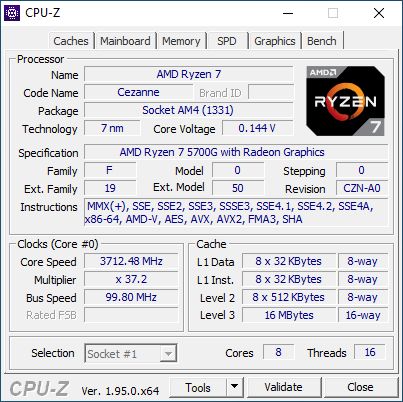

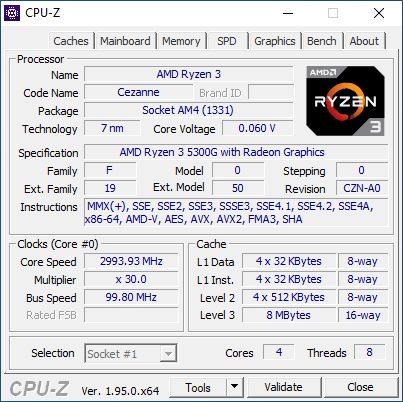
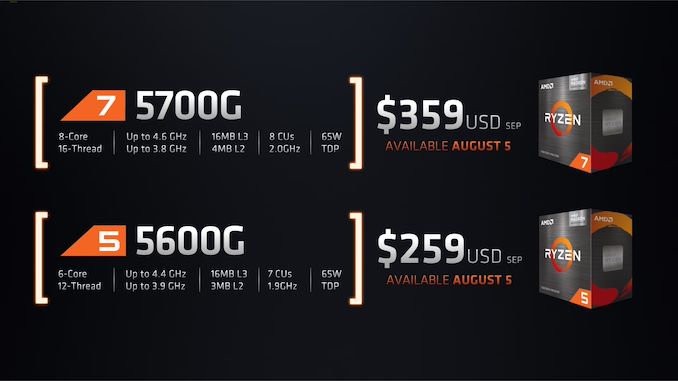
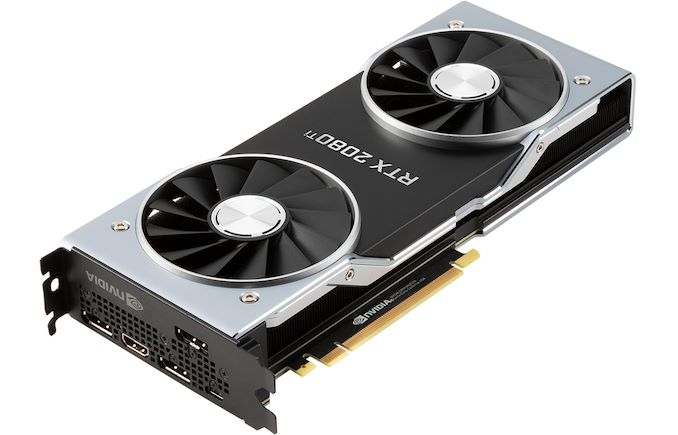
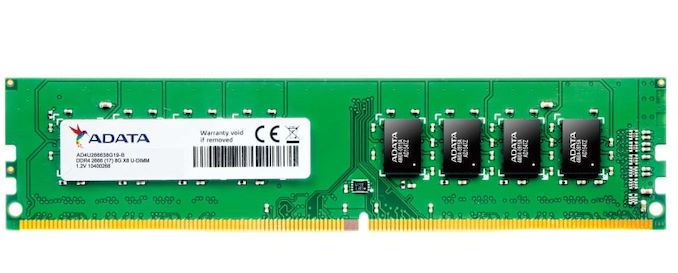








135 Comments
View All Comments
Wereweeb - Wednesday, August 4, 2021 - link
The bottleneck is memory bandwidth. DDR5 will raise the iGPU performance roof by a substantial amount, but I hope for something like quad-channel OMI-esque Serial RAM.abufrejoval - Saturday, August 7, 2021 - link
I'd say so, too, but...I have just had a look at a Kaveri A10-7850K with DDR3-2400 (100 Watt desktop), a 5800U based notebook with LPDDR4 (1333MHz clock) and a Tiger Lake NUC with an i7-1165G7 with DDR4-3200.
The memory bandwidth differences between the Kaveri and the 5800U is absolutely minor, 38.4 GB/s for the Kaveri vs. 42.7GB/s for Cezanne (can't get the TigerLake figures right now, because it's running a Linux server, but it will be very similar).
The Kaveri and Cezanne iGPUs are both 512 shaders and apart from architectural improvements very much differ in clocks 720MHz vs. 2000MHz. The graphics performance difference on things like 3DMark scale pretty exactly with that clock difference.
Yet when Kaveri was launched, Anandtech noted that the 512 shader A10 variant had trouble to do better then the 384 shader APUs, because only with the very fastest RAM it could make these extra shaders pump out extra FPS.
When I compared the Cezanne iGPU against the TigerLake X2, both systems at tightly fixed 15 and 28Watts max power settings, TigerLake was around 50% faster on all synthetic GPU benchmarks.
The only explanation I have for these fantastic performance increases is much larger caches being very smartly used by breaking down GPU workloads to just fit within them, while prefetching the next tile of bitmaps into the cache in the background and likewise pushing processed tiles to the framebuffer RAM asynchronously to avoid stalling GPU pipelines.
And yet I'd agree that there really isn't much wiggling room left, you need exponential bandwidth to cover square resolution increases.
abufrejoval - Saturday, August 7, 2021 - link
need edit!Is TigerLake Xe, not X2.
Another data point:
I also have an NUC8 with an 48EU (+128MB eDRAM) Iris 655 i7 and a NUC10 with an 24EU "no Iris" UHD i7. Even with twice the EUs and the extra eDRAM (which I believe can be used in parallel to the external DRAM), the Iris only gets a 50% performance increase.
The the 96EU TigerLake iGPU is doing so much better (better than linear scale over UHD) while it actually has somewhat less bandwidth (and higher latency) than the 50GB/s eDRAM provides for the 48EU Iris.
bwj - Wednesday, August 4, 2021 - link
Why are these parts getting stomped by Intel and their non-graphics Ryzen siblings?bwj - Wednesday, August 4, 2021 - link
Meh, meant to say "in browser benchmarks". Browser is an important workload (for me at least) and the x86 crowd is already fairly weak versus Apple M1, so I'm not ready to throw away another 30% of browser perf.Lezmaka - Wednesday, August 4, 2021 - link
There are only 3 browser tests and for two of them the 5700G is within a few percent of the 11700K. But otherwise, it's because these are laptop chips with higher TDP. The 11700K has a TDP of "125W" but hit 277W where the 5700G has a TDP of 65W and maxed out at 88W.Makaveli - Wednesday, August 4, 2021 - link
There is something up with the browser scores here anyways compared to what you see in the forum. All the post with similar desktop cpu's in that thread post much high scores than what is listed in the graph. I'm not sure its old browser version being used to keep scores inline with older reviews or something.https://forums.anandtech.com/threads/how-fast-is-y...
abufrejoval - Wednesday, August 4, 2021 - link
When you ask: "Why don't they release the four core variant?" you really should be able to answer that yourself!There are simply not enough defective chips to make it viable just yet. Eventually they may accumulate, but as long as they are trying to produce an 8 core chip, 4 and 6 cores should remain the exception not the rule.
I'd really like to see them struggle putting the lesser chips out there, because it means my 8/16(/32/64) core chips are rock solid!
I would have liked to see full transistor counts of the 5800X and the 5700U side by side. My guess would be that the Cezanne dies even at 50% cache have more transistors overall, meaning you are getting many more pricey 7nm transistors per € on these APUs and should really pay a markup not a discount.
Well even the GF IO die fab capacity might have customers lined up these days, but in normal times those transistors should be much more commodity and cheaper and have the APU cost more in pure foundry (less in packaging) than the X-variants, while AMD wants to fit it into a below premium price slot where it really doesn't belong.
nandnandnand - Wednesday, August 4, 2021 - link
If AMD boosted chiplet/monolithic core count to 12, maybe 6 cores could become the new minimum with 10-core being a possibility. But it doesn't look like they plan to do that.Wereweeb - Wednesday, August 4, 2021 - link
These might have been a stockpile of dies that were rejected for laptop use (High power consumption @ idle?) and they're being dumped into the market after AMD satisfied OEM demand for APU's.Plus, considering that one of the main shortages is for substrates, it's possible that the substrate for the APU's is different - cheaper, higher volume, etc... as it doesn't need to interconnect discrete chiplets.